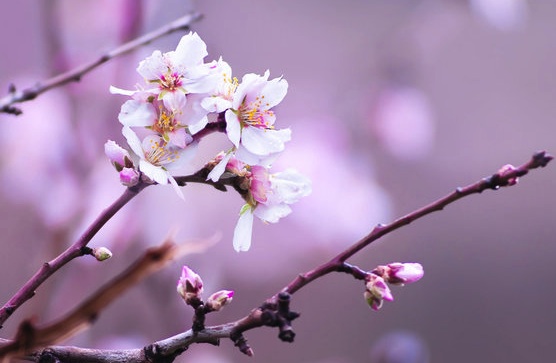 The Jewish holiday of Tu B’Shvat, a day especially loved by children, is a special eco-day in Israel. Celebrate it with a fruity feast.
The Jewish holiday of Tu B’Shvat, a day especially loved by children, is a special eco-day in Israel. Celebrate it with a fruity feast.
It’s true, a few days before the Jewish holiday of Tu B’Shvat occurs, the almond trees in Israel begin to shake blossoms out along their branches. Travelers along the Tel-Aviv-Jerusalem highway can spot the occasional cloud of pink or white flowers among the olive groves and green fields along the way. Enjoy the beauty of mid-winter in Israel, because soon enough summer’s hot winds will change the landscape to something much drier and sere.
Strolling on ground covered with almond blossom is a lovely thing to do, and the milky new almonds, sco0ped out of their fuzzy green shells, are delicious eating. In a few weeks, you’ll be able to buy sacks of them in the open-air markets. Another way to celebrate the gracious almond tree is by picking up the best and freshest of those fallen blossoms and making almond blossom liqueur.
The Jewish new year of the trees determines which agricultural year their fruit belongs to, as explained in this post. The day is also called a new year because, as for humans, Heaven determines each tree’s fate that day. How much water will it receive? (Some of that has to do with not wasting water ourselves.) Will it survive to fruition one more year, or not?
A song Israeli kindergartners sing on Tu B’Shvat:
The almond tree is blooming
The golden sun is shining,
Whistling birds atop each roof
Bless the day’s oncoming.
 We eco-conscious treehuggers can also ask ourselves how active our commitment to stewardship has been this past year – what we’re doing to prevent a scenario as depicted by this artist, in a world with no trees.
We eco-conscious treehuggers can also ask ourselves how active our commitment to stewardship has been this past year – what we’re doing to prevent a scenario as depicted by this artist, in a world with no trees.
Tu B’Shvat gained special mystical importance in Safed’s 16th century kabbalistic traditions. The great Rabbi Isaac Luria instituted a Seder for the holiday in which participants eat thirty kinds of fruits and drink four colors of wine, stopping to meditate on the symbolism of each variety. It’s also great fun; remember, you’re expected to drink four cups of wine!
Read our post on the Tu B’Shvat seder, which includes a link to downloading instructions on how to conduct one. For some recipe ideas, follow the links below. And remember safety for your little ones under age five: cut hard fruit like apples into small pieces; likewise cut grapes in half; and either don’t allow them nuts, or break nuts up into small, un-chokable pieces ahead of time.
Some recipes that celebrate the native fruits of Israel:
- Almond Torte with Pomegranate Molasses
- Carob Nut Balls
- Cool and Hot Arabic Almond Milk
- Warm Freekah, Feta, and Fig Salad
Images of almond blossom and green almonds via Shutterstock.



